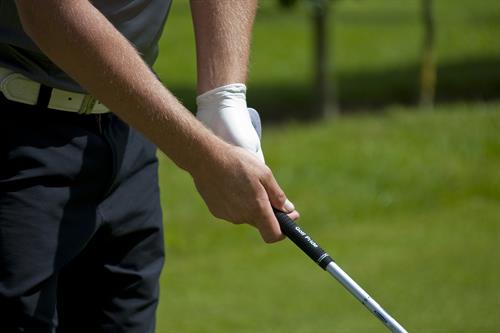Golf Grip Tips that Will Make a Difference in Your Game
By Dan Williams, PGA Professional & Golf Instructor at Superstition Mountain Golf and Country Club

There is a belief that how you grip the golf club is the most important aspect in golf. It’s hard to argue that this is untrue considering how you put your hands on the club can have some massive effects on how you hit the ball. While I don’t believe you need a perfect grip to hit effective golf shots, having a bad grip can certainly make it almost impossible to hit successful ones. So, what matters in your grip?
If you’ve had someone help you with your game, you’ve probably been taught to interlock or overlap your fingers, which can feel very strange if you’re not used to it. You try your best, but it never feels quite right. So what’s the big deal about this grip? Interlocking or overlapping your grip does a couple of things that are valuable. It connects your hands together and makes it harder to overuse your wrists and helps with not gripping too tight. Notice that I did not say it ensures that you won’t make those mistakes. The right grip is not magic after all. If you don’t like the feel of interlocking or overlapping, you can certainly grip it with all 10 of your fingers and be just fine. It’s worth trying, but it is not required!
If you play/played other stick sports like baseball or tennis, it can be easy to try and grab a golf club in a similar way. The trouble with this is that a golf club has a much smaller grip and if you use your entire hand or palm of your hands to grip the club, you won’t be able to hold the club tightly enough have a full control. Additionally, it might not allow your wrists to work well. If you grip the club with your fingers, you’ll have a much better chance of making a good swing.
If you watch a young golfer swing a club, it is very common for them to have space between each of their hands. This looks wrong, so we tell them to put their hands together only to watch them split the grip again in a swing or two. When a young golfer splits their hands on the grip this can be their way of trying to lighten the club in their swing so they can control the club rather than be controlled by the swinging club. I would much rather see the junior coordinate the body movements required to move the club rapidly with some control rather than have them focus on their grip and making the club too heavy to swing.
They’ll have plenty of time to improve their grip as they get older, stronger and more skilled.
I often suggest that people change their grip to change their ball flight. Naturally, some people are very resistant to this because that’s how they’ve held the club for their entire life. I understand this struggle, but if you have a weak grip and you hit high slices, changing how your top hand sits on the club could change your ball flight very quickly. This is not automatic, but it can be very impactful. Here’s a quick guide.
Weak grip means that the back of your top hand is pointing more towards the target. This promotes an open club face which will hit the ball higher and to the right for a right handed golfer.
Strong grip means that the palm of your top hand is facing more inward towards your body. This promotes a closed club face which will hit the ball lower and to the left for a right handed golfer.
In this situation, strong doesn’t mean good or bad and weak doesn’t mean good or bad, they are just the terms we use to describe how the top hand is on the club. So, if you struggle with high slices, you might try to strengthen your grip and if you hit low hooks, you might try to weaken your grip.
We could go on and on talking about grip, but I find these topics to be the most interesting and helpful!
For more tips, check out Dan’s recent blog How Ball Position and Stance Can Help Your Golf Game.
To book a lesson with Dan, shoot him an email at: dwilliams@superstitionmtngc.com


